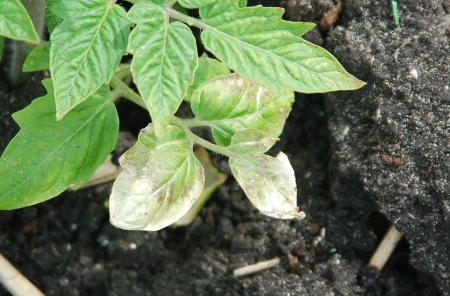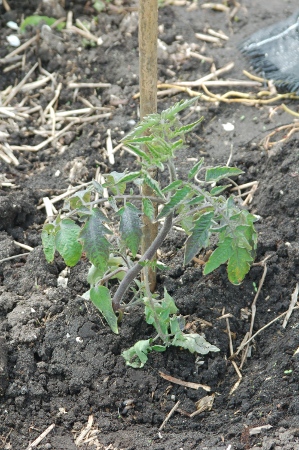Like on the leaves above, from time to time I have problems with sun scald on tomato plants, both on the leaves and fruits. This is especially true the last few years as the ozone layer has been thinning over Europe.
One of the things Tom Wagner mentioned when I visited him, was with the new blue tomatoes, the blue pigment reacts to sunlight not only to intensify the blue color, but also to protect the plant against sun scald!
The tomato here was close to the one above, but you can see instead of getting scalded, it’s acquiring blue pigment in the leaves. This is one of Tom’s Helsing Junction Blues tomatoes. The seeds he gave me were F2 or F3, so still very variable. If you’re growing the same tomato, it might look different. Also, I have a few others of the same variety, and they are also different.
To be honest, I hardly bother to grow tomatoes anymore. There are just too many instantly fatal things that can happen with them, the most serious being the blight we get every year. I was interested in trying a blue variety, and I’m also growing one of Tom’s blight resistant Skykomish tomatoes next to it, so the blue variety is sort of acting as a control plant.




Funny.. a few moments ago I noticed one of my many tomato plants has blue to the leaves like I have never seen…it’s a variety I have not grown before.
I guess by now you know anonymous could be Cynthia who forgot her name once again…..
Thanks, Patrick, for mentioning the sun scald resistant properties that the blue tomatoes might possess. Even varieties like OUT OF THE BLUE which has the blue stems and leaves but red fruits seem to be important innovations. I intend to breed the blue foliage only trait into quite a few tomato varieties this summer. I think putting the gene into many tomato varieties may be a valuable protection. Of course, other researchers need to report their findings.
Tom Wagner
Thanks for the comments.
I didn’t give a lot of thought to the difference between blue foliage and fruits when I wrote this, and I’m pleased to have that clarified.
I hope everyone will note Tom’s comment about reports from other researchers being needed. That means you! If you’re growing tomatoes with blue foliage or fruits, please let us know what you think.
Good luck growing these. They sound pretty interesting. Why do you get blight each year? Do you grow potatoes and eggplants then? (I’ve been out of the loop for a bit, so please forgive me if you’ve already answered these questions elsewhere.) Looking forward to hearing more!
Hi Joan,
It’s nice to hear from you again. It’s been a while.
The reason we get blight each year is a hot topic here. The main reason is we just have the perfect climate for blight, cool and damp.
If you were a commercial farmer, you might say the reason we get blight are the organic farmers. This is because when organic farmers don’t spray, their plants host and spread blight, don’t you know… In fact there are strict laws here that put organic farmers at a big disadvantage, mandating infected plants must be destroyed, or at least have their foliage removed, unrealistically quickly. Commercial farmers can use chemicals to destroy the foliage on their plants, but organic farmers not.
If you’re a big seed company, the argument goes that we have blight because not everyone grows GM potatoes. This is because, according to them, GM potatoes are 100% blight resistant, can’t host the pathogen, and if everyone used them blight would eventually go away.
If you’re an organic grower like me, you probably blame the large commercial monocultures for hosting and spreading the pathogen, the chemicals that damage the environment, and you would probably call the big seed companies liars when they claim their GM potatoes are 100% blight free.
We have this discussion here regularly.
Blight on potatoes is usually manageable like I describe above, by removing infected foliage. With tomatoes blight is usually instantly fatal, but can often be managed by growing indoors. Eggplants aren’t really a northern crop, and aren’t grown a lot here. I’ve never had much luck with them. I don’t know if blight is an issue for them or not.